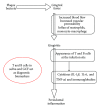Periodontal proteomics: wonders never cease!
- PMID: 24490073
- PMCID: PMC3893808
- DOI: 10.1155/2013/850235
Periodontal proteomics: wonders never cease!
Abstract
Proteins are vital parts of living organisms, as they are integral components of the physiological metabolic pathways of cells. Periodontal tissues comprise multicompartmental groups of interacting cells and matrices that provide continuous support, attachment, proprioception, and physical protection for the teeth. The proteome map, that is, complete catalogue of the matrix and cellular proteins expressed in alveolar bone, cementum, periodontal ligament, and gingiva, is to be explored for more in-depth understanding of periodontium. The ongoing research to understand the signalling pathways that allow cells to divide, differentiate, and die in controlled manner has brought us to the era of proteomics. Proteomics is defined as the study of all proteins including their relative abundance, distribution, posttranslational modifications, functions, and interactions with other macromolecules, in a given cell or organism within a given environment and at a specific stage in the cell cycle. Its application to periodontal science can be used to monitor health status, disease onset, treatment response, and outcome. Proteomics can offer answers to critical, unresolved questions such as the biological basis for the heterogeneity in gingival, alveolar bone, and cemental cell populations.
Figures





Similar articles
-
Developmental pathways of periodontal tissue regeneration: Developmental diversities of tooth morphogenesis do also map capacity of periodontal tissue regeneration?J Periodontal Res. 2019 Feb;54(1):10-26. doi: 10.1111/jre.12596. Epub 2018 Sep 12. J Periodontal Res. 2019. PMID: 30207395 Review.
-
Healing of periodontal defects treated with enamel matrix proteins and root surface conditioning--an experimental study in dogs.Biomaterials. 2004 May;25(10):1831-40. doi: 10.1016/s0142-9612(03)00468-x. Biomaterials. 2004. PMID: 14738847
-
[Extract of cemental matrix enhance periodontal cells bind to the root surface].Hua Xi Kou Qiang Yi Xue Za Zhi. 1999 May;17(2):122-4. Hua Xi Kou Qiang Yi Xue Za Zhi. 1999. PMID: 12539702 Chinese.
-
Cellular origins and differentiation control mechanisms during periodontal development and wound healing.J Periodontal Res. 1994 Mar;29(2):81-94. doi: 10.1111/j.1600-0765.1994.tb01095.x. J Periodontal Res. 1994. PMID: 8158503 Review.
-
Immunohistochemical localisation of extracellular matrix proteins in the periodontium during cementogenesis in the rat molar.Arch Oral Biol. 2003 Oct;48(10):709-16. doi: 10.1016/s0003-9969(03)00131-6. Arch Oral Biol. 2003. PMID: 12971948
Cited by
-
20 abnormal metabolites of Stage IV Grade C periodontitis was discovered by CPSI-MS.Pathol Oncol Res. 2022 Dec 7;28:1610739. doi: 10.3389/pore.2022.1610739. eCollection 2022. Pathol Oncol Res. 2022. PMID: 36567980 Free PMC article.
-
Transcriptome landscape comparison of periodontium in developmental and renewal stages.Front Endocrinol (Lausanne). 2023 Mar 15;14:1154931. doi: 10.3389/fendo.2023.1154931. eCollection 2023. Front Endocrinol (Lausanne). 2023. PMID: 37008900 Free PMC article.
-
Proteomics Disclose the Potential of Gingival Crevicular Fluid (GCF) as a Source of Biomarkers for Severe Periodontitis.Materials (Basel). 2022 Mar 15;15(6):2161. doi: 10.3390/ma15062161. Materials (Basel). 2022. PMID: 35329612 Free PMC article.
-
Oral microbiome and peri-implant diseases: where are we now?Ther Clin Risk Manag. 2017 Nov 29;13:1529-1542. doi: 10.2147/TCRM.S139795. eCollection 2017. Ther Clin Risk Manag. 2017. PMID: 29238198 Free PMC article. Review.
References
-
- McCulloch CA. Proteomics for the periodontium: current strategies and future promise. Periodontology 2000. 2006;40(1):173–183. - PubMed
-
- Armitage GC. The complete periodontal examination. Periodontology 2000. 2004;34:22–33. - PubMed
-
- Kathariya R, Pradeep AR. Salivary proteomic biomarkers for oral diseases: a review of literature. American Overseas School of Rome. 2010;1:43–49.
-
- Collins FS, Green ED, Guttmacher AE, Guyer MS. A vision for the future of genomics research. Nature. 2003;422(6934):835–847. - PubMed
-
- Wilkins MR. From proteins to proteomes: large scale protein identification by two-dimensional electrophoresis and amino acid analysis. Bio/Technology. 1996;14(1):61–65. - PubMed
Publication types
LinkOut - more resources
Full Text Sources
Other Literature Sources
